Colgate Advertising Strategy: How The Perfect Smiles Spread Across The Globe
If I ask you which is the first toothpaste brand that comes to your mind, you won’t need much thinking to come up with the name of Colgate. All around the world, the oral hygiene brand has maxed its reputation for helping individuals to have perfect smiles and exceptional white teeth. For a brand that first came to the market more than one hundred years ago, Colgate is still strong in the industry’s leading position.
How did Colgate become the most well-known product in the oral care field? And how can it keep the high status that almost seems unbreakable? A large contributing factor would be Colgate’s advertising strategy that promoted the perfect smile to be a new standard for human health. Not only that, but the company also focused on helping customers with oral hygiene and education.
In this article, I am going to show you the in-depth analysis of the Colgate advertising strategy and why it helped Colgate achieve its current top position on the toothpaste market. History, campaign, and modern marketing activities would all be included, so you are in for an informative lesson. Let’s smile bright and get started!
Colgate introduction

Colgate is an American company that specializes in oral hygiene products such as toothpaste, toothbrushes, dental floss, and mouthwashes. Manufactured and owned by Colgate-Palmolive, the first Colgate toothpaste was sold in 1873 in New York, eighteen years after the death of the company’s founder - William Colgate. The company previously sold soap.
Colgate sells through a variety of retail and wholesale partners, distributors in North America, Europe, Latin American, Asia Pacific, and Africa. The total brand worth of Colgate-Palmolive is estimated at about $62 billion, and the revenue is about $15.69 billion by Forbes. In 2015, Colgate was the only brand in the world purchased by more than half of the global households. Its global market penetration was nearly 50%, with 40 million new households purchasing the brand’s products each year.
As a leading consumer products company, Colgate (or Colgate-Palmolive) has committed to advancing technology that can adapt to the consumer’s changing needs throughout the world. Its goal is to use technology to create products that can continue improving the quality of life for customers everywhere. Forbes ranks Colgate number 69 on the list of the most valuable brands on the planet.
With a long history, Colgate has become a household name in the oral hygiene industry while constantly introducing new products to the public. The name itself has been commoditized, as you can come to any corner of the world and still find Colgate products existing. Colgate also continues to be the largest source of income for the parent company, making up around 47% of the total sales globally.
Colgate SWOT analysis

Colgate has a wide range of products for oral and personal care. To keep the global production chain running for billions of products every year, Colgate has built many strong factors to support the company and consumer’s needs. However, Colgate still faces unavoidable challenges and weaknesses. In this section, we will analyze Colgate in the SWOT formula (Strengths - Weaknesses - Opportunities - Threats) to better understand the company.
Colgate’s Strengths
- Brand visibility: Being the household name in the oral hygiene industry, Colgate has high brand visibility and recall. The company has done wonderful work in advertising and promoting products to gain a strong and loyal customer base. This is a key factor for Colgate to compete with other players like P&G, HUL, and even the movement of local products.
- Efficient supply chain: Colgate has a sophisticated distribution network in both rural and urban areas, which ensures that it reaches a wide range of customers with products always available. Product availability is a major factor in the highly competitive market since customers can switch brands very easily.
- Product line: Colgate has products in toothpaste, toothbrushes, mouthwashes, kid products, professional specialty products, and prescription-only products for a full range of oral care. In the Fast-Moving Consumer Goods (FMCG) world, the more in-depth the product line is, the more chance for success since it can reduce the cost of logistics.
- Financial: Being more than one century old and having operations in 200 countries has established a strong financial base for Colgate. Not to mention, it has support from the parent company. This is a strong strength to take on other competitors.
- Market share: Colgate has managed to hold a huge market share with high penetration over the years. Some of the brand’s products remain to be the market leaders in particular regions.
Colgate’s weaknesses
- Saturated market: With many new players, both international and domestic fighting in the personal oral care segment, the market becomes smaller, and there is little space left to grow. When every market is fighting for each other’s market share, Colgate will face a lot of competition.
- Cost control: Colgate needs a high cost of operation due to the gigantic properties and machine. The profits can decrease, but the operation chain still needs to work constantly. And because of this, Colgate products can be priced higher than the rivals’.
- Limited brand’s potential: Colgate is entirely under a particular product category and segment, which means it has limited offerings to the customers, unlike the competitors who can reach to many other fields like P&G or HUL.
Colgate’s opportunities
- Expanding the product line: By using the existing production line and stretching the existing product categories, the company can increase sales, create new offerings, and earn values from different segments.
- Strengthening the business’s position through mergers and acquisitions: Global companies with large capital has a smart strategy to sustain and expand overseas by acquiring rising companies. However, Colgate is yet to capitalize on the market by using this strategy.
- Tapping into the rural market of developing countries: With urban markets becoming more saturated with competition, the rural markets become the untapped gold mine that Colgate can use to reap profits. However, it needs to be quick since others can have the same idea.
- Usage rate: The company plays an important role in making people aware of the optimum usage rate of the products. This can be done through advertising, word of mouth, and doctor advice. Colgate also needs to forecast this number to effectively penetrate new markets.
Colgate’s threats
- Market competition: With a staggering number of new brands, it can be difficult for Colgate to differentiate itself from others. There is also the threat of the brand image being damaged by the counterfeit products on the market.
- Material’s price: The continual increasing price of raw materials will affect Colgate’s pricing strategy directly. Over time, it will be harder to justify the high price and result in sales decrease as well as brand switching rate increases.
- Low margins: To stay in a saturated market, Colgate may have to give more and more discounts to sustain its position, which leads to lower margins and less profit.
- Frequent brand switching: This is an unavoidable threat since there are full of other brands claiming all sorts of superior benefits; customers would hardly stick to a particular brand. Several factors can affect the consumer’s choice, such as availability, price, preference, recommendation, and simple curiosity.
- Ethical issues: Animal testing, the deceptive claim of dentists’ recommendations, and unhealthy materials, whether these are true or not, have been concerned about Colgate stated by acclaimed media sources. This information is likely to affect the brand image of Colgate.
Colgate advertising strategy
Colgate has positioned its toothpaste products as mainstream with a competitive pricing policy (slightly higher than the competitors’). The strategy plays with purchaser psychology by portraying the products that have better oral effects and longer duration. But this cannot work without proper advertising strategy to strengthen the claim. Here is what Colgate has focused on in its advertising strategy to promote the brand image worldwide.
A global program

You may have encountered this program as a child, too; it is called the Colgate Bright Smiles, Bright Future program with the aim to provide free dental screenings and oral health education to children worldwide. It is one of the most far-reaching advocacies that any brand has ever achieved. The program turns Colgate into a global act of education, way beyond a simple toothpaste brand.
Bright Smiles, Bright Future, includes multicultural education material for children to educate about keeping teeth and gums healthy. In the US, Colgate promoted the program with a fleet of mobile dental vans that travel across 50 states of the country to provide free dental education and screenings.

The program has made a huge impact on the world. In 2018, it celebrated reaching one billion children in 80 countries. It is a prime example of advocacy that a business can aim to make a difference in the world and promote the brand’s image. In 2021, the program aims to reach 300 million more children.
Lately, due to the impact of Covid-19, Colgate supported the #SafeHands message from the World Health Organization and donated 15 million soap bars to many global agencies. The movement was accompanied by the brand ambassador, Michael Phelps. Colgate also donated $20 million in health and hygiene products to the world’s community-based organizations. Many more actions were taken, including a viral Youtube video promoting the campaign’s message of “Let’s share our smiles for the masked heroes” - which gained over 4.5 million views.
Collaboration with influencers and experts
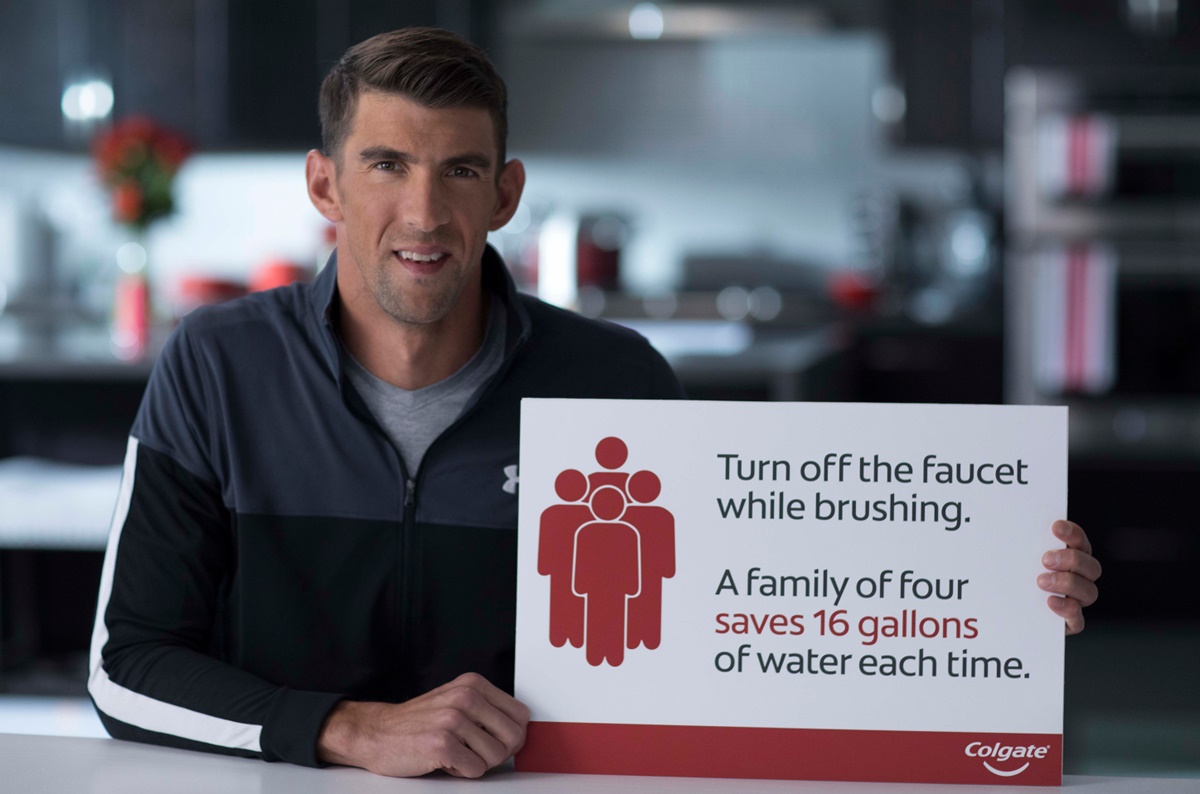
In order to meet all the wants and needs of the consumers, Colgate would need help from the key opinion leaders. The company has had countless advertising campaigns through the media like television, radio, magazines, newspapers, and numerous billboards. Social media has also become a favorable marketing tool, where influencers appear naturally.
Many dentists were contacted to examine and give honest recommendations for Colgate products, so the brand became a trustworthy company in the consumers’ eyes. In order to maintain a personal relationship with the consumers, the brand has accounts on all the major social networking sites like Facebook, Twitter, Instagram, and Youtube. Here, customers are encouraged to share their experiences.
Many celebrities have participated in the company’s campaigns at various intervals to promote the product and the brand’s message. Its brand ambassadors include both big stars (Micheal Phelps, Sloan Stephens, Yvonne Orji, etc.) and minor influencers, especially Youtubers to maximize the reach. We will get to a worth-mentioning Youtube campaign later.
What to keep in mind is that the collaboration always aims at a noble cause that Colgate tries to pursue, like in education or environment awareness. The campaigns stay true to the brand’s helpful characteristics and promote a truly healthy brand image.
Smart marketing campaigns
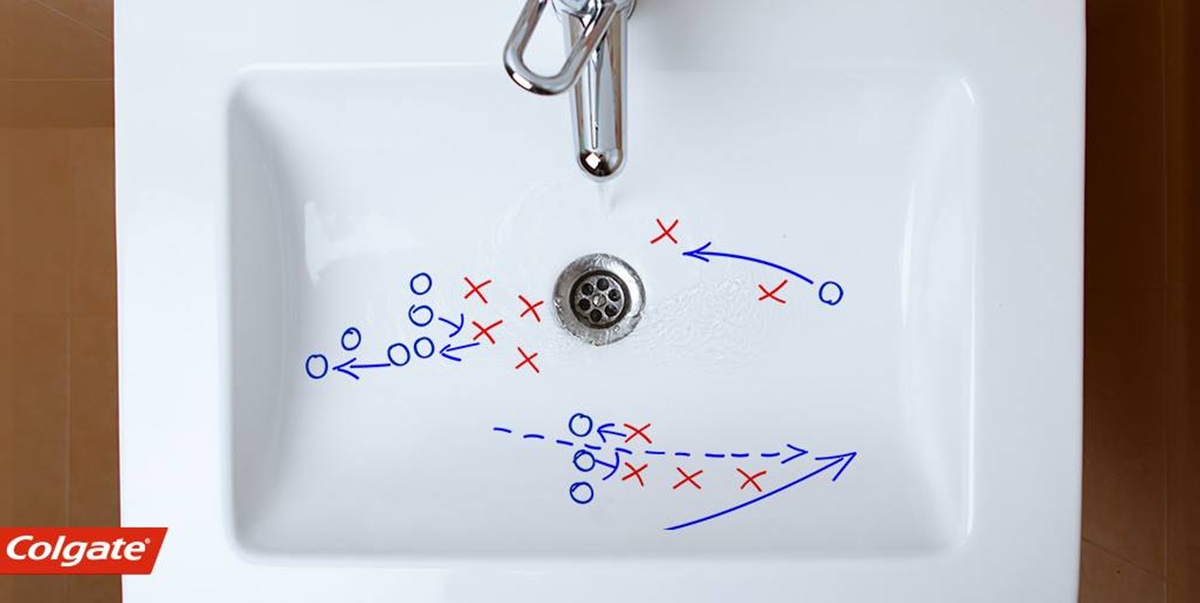
While Colgate remains a serious tone in the company’s world mission, its advertising strategy saw some good humor too. It was a brief time, but you can still find some creative and funny ads on the internet, both in forms of images and videos. After 2014, Colgate primarily used marketing campaigns to promote health awareness and educational information.
This is still a smart approach since it promotes a persistent brand image and actions. The humorous element still exists once in a while but is toned down, so the main message is clearly represented. Take the campaign of “Every Drop Count” as an example. The goal is to promote awareness in saving water for a better world. So the Facebook image above is created to bring humor into the message. While Micheal Phelps did a great job explaining the campaign’s advocacy, images like these helped far reach the campaign to more audiences.
Below, you will find another smart marketing campaign that Colgate has made to promote its line of flossing products. Here are some of the best Colgate’s campaigns that successfully advertised the brand.
Colgate’s notable campaigns
The Smile Show - a Youtube show collaborated with influencers
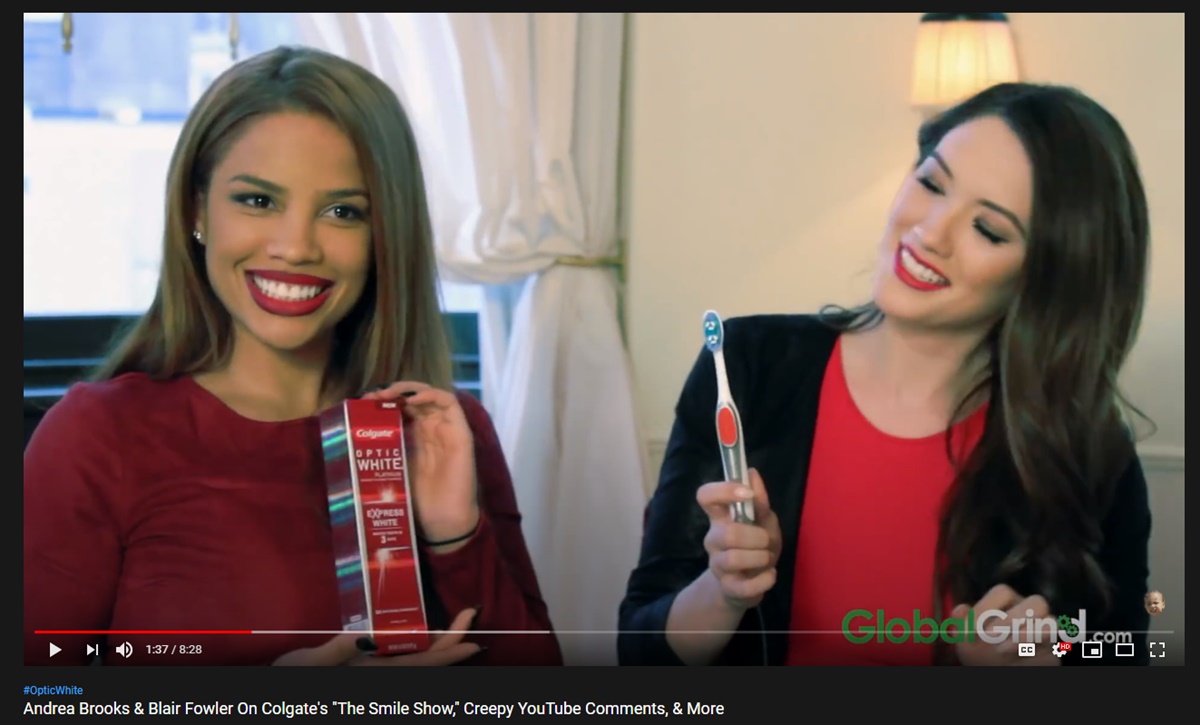
To get exposure on Youtube, you need fun and actionable branded content to invite the audience to join the experience. This is what Colgate did when it integrated Youtube into its advertising strategy with The Smile Show, which mainly targets on the millennials viewers.
Back then, Colgate would try to be appealing through TV ads and print, but Youtube was actually the place where millennials are active, so it is a perfect channel to reach and connect with younger audiences. The Smile Show includes a series of videos that promote Colgate, in which the brand collaborated with Youtubers Blair Fowler and Andrea Brooks to gain massive 24 million views.
The influencers were not just spokespeople, they were also triers and commentators on what Colgate products can do to help with people’s smiles. Each video contains a different Colgate product. Promotions for the show took place on desktop and mobile via the Youtube masthead, Hangout on Air, GDN banners, TrueView ads, and a YouTube channel gadget.
The efforts were worth it, since the show led to a 13% increase in brand awareness and a 10.8% increase in purchase consideration, along with an 1116% increase in the brand interest. That is a massive increase. A Youtube show about accentuating smiles can be that big of a hit, Colgate surely won big with this campaign.
A humorous campaign with photoshop disasters
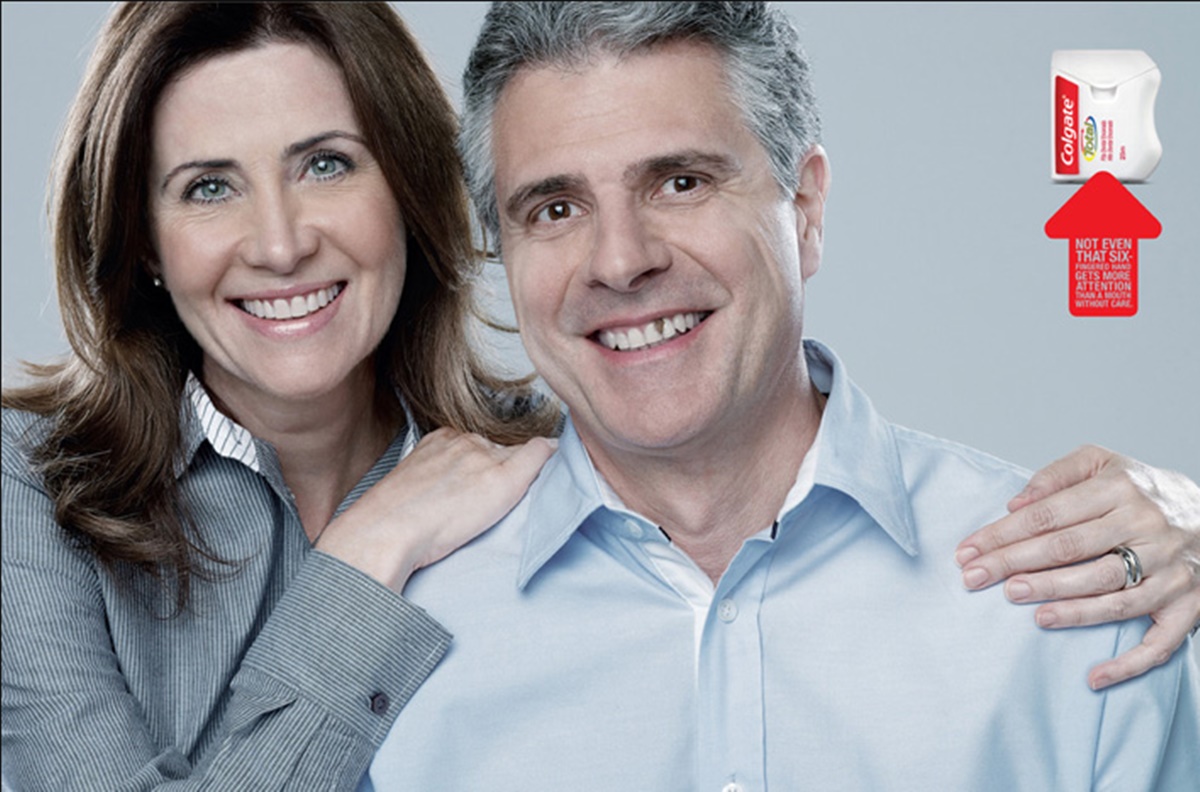
In 2012, Colgate teamed up with agency A&R Brazil to create some really clever advertising photos for a new line of dental floss. What stood out was the creative direction to make people realize just how important personal hygiene is and dental floss can help people fix that. See the pictures for yourself and see if you can figure out what is wrong with them.
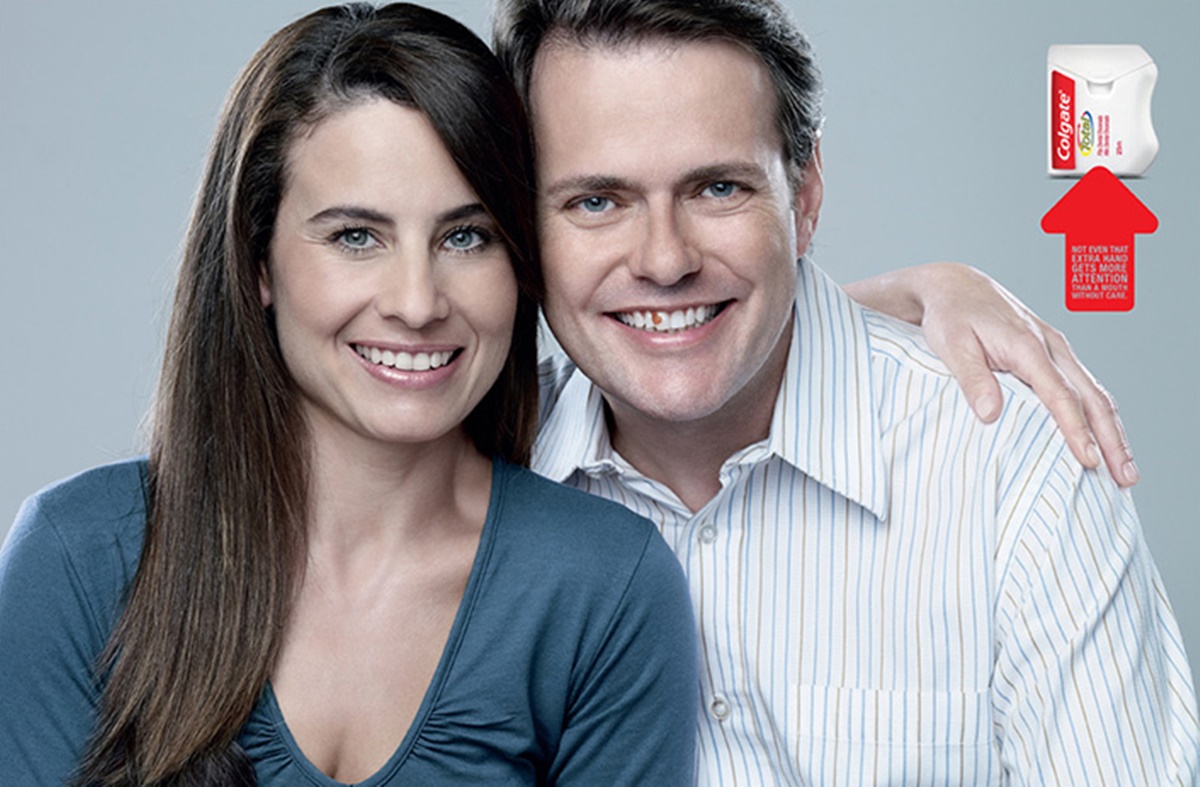
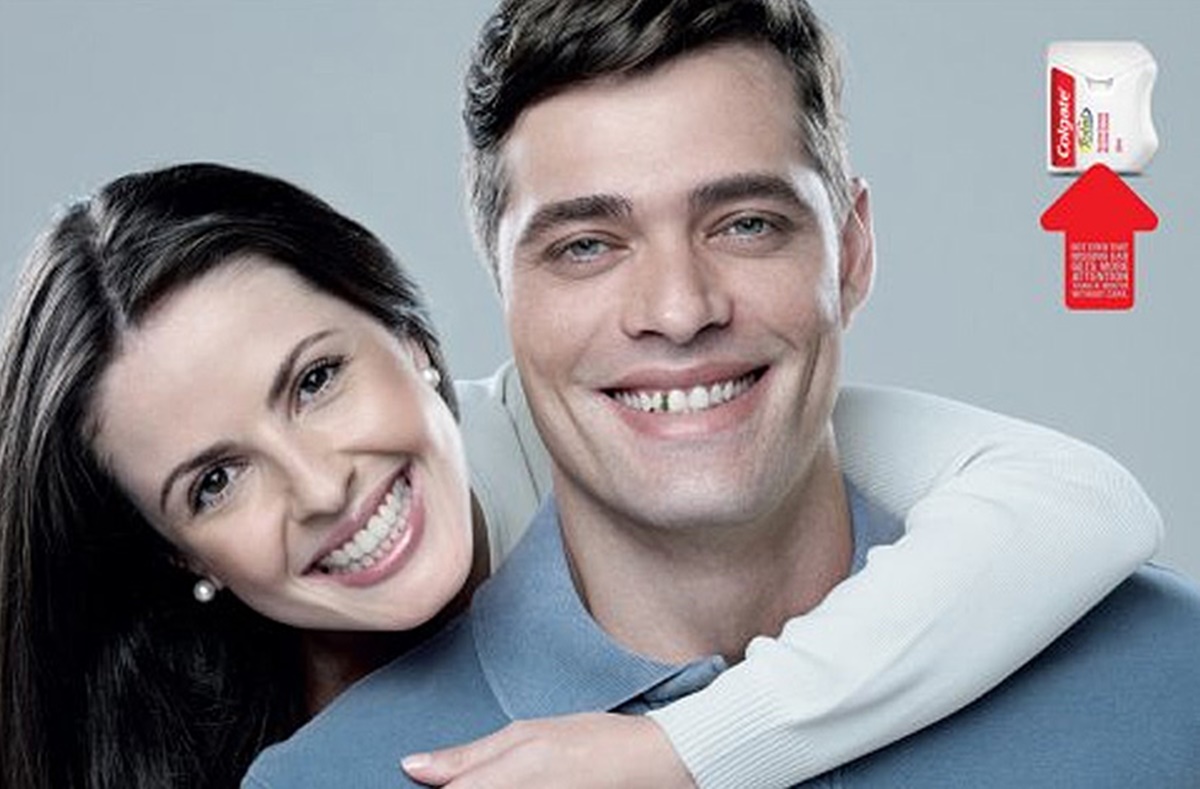
Could you see that the lady in the first photo has an extra finger? Or the extra arm resting on the guy’s shoulder in the second photo? Or the guy in the last photo has only one ear? Or you saw that their white teeth have something between them first? The clever photos successfully demonstrate that remaining food can draw way more attention than any physical defect.
The message that Colgate sent was clear but in a really funny way. By highlighting the importance of flossing and brushing, the company made viewers stop, stare, and have an amazing “aha” moment that immediately put the brand into their minds. This way, consumers easily understand the importance of flossing and remember the brand’s humor.
Location-based targeting campaign to reach consumers

Maha Kumbh Mela is a big spiritual gathering of the Hindus in India. This is a promising market that if Colgate can tap into, it has access to almost a billion new customers. That is why the company thought of a creative advertising campaign to promote the brand and its product.
First, Colgate understood that most of the Hindu in the target area had a low literacy rate. So voice-based communication is the better way to promote. But, secondly, many people have smartphones or phones that can collect radio signals, so transmitting the message through mobile phones was a good idea.
So Colgate used location-based targeting to create a virtual circle around the pilgrimage site by using the nearby cellular towers. When people entered this circle, their phones were connected and received a call from Amin Sayani - a well-known Indian radio personality, telling them to visit a nearby Colgate booth for free samples, entertainment, and a chance to win prizes.
With a limited budget of only $8,000, the campaign increased over 300% of foot traffic to the Colgate booth and attracted over 700,000 visitors. The location-based targeting method was primarily used in only metropolitan areas and via text messaging or banner ads, so this campaign is actually the first of its kind in India. A new method to reach consumers but is still very effective.
What you can learn from Colgate
Here is a quick recap of the lessons that you can learn from Colgate and apply to your own advertising strategy:
- Advocacy can be the driving force to push your brand’s image beyond the products, think globally.
- Influencers are important to deliver the brand’s message, especially when they can say it right.
- New and creative ways to do advertising is what a company needs to tap into new audiences and penetrate new markets.
Final advice
For over a hundred years, Colgate has maintained its position as a leading company in the oral hygiene industry, and that is no luck. Through a smart advertising strategy, Colgate could utilize its strengths and grab new opportunities in untapped markets to further promote itself as a global brand. The responsibility that the company takes keeps growing with the size of the organization, too, making Colgate a prime example of a big company with worthy advocacy.
That is what you can think of for your own brand? In a hundred years later from now, where would your brand be and what good would it do for the world? A long-term approach like this can take you really far on the road and overcome the threats that the markets always propose. Thanks for reading, and if you have any questions, leave them in the comment section below.
New Posts






